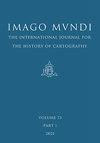对约翰·罗克的新认识:他的雕刻艺术家生涯和他的两幅伟大的城市地图:伦敦(1746)和都柏林(1756)
IF 0.5
4区 历史学
Q4 GEOGRAPHY
Imago Mundi-The International Journal for the History of Cartography
Pub Date : 2022-01-02
DOI:10.1080/03085694.2022.2042125
引用次数: 0
摘要
在18世纪中期重要的地图绘制家约翰·罗克(John Rocque)的文献证据稀少的背景下,本文试图通过对他的作品进行更广泛的抽样研究,来审视胡格诺派专业生涯的性质和发展。这需要承认他作为一名装饰和地形雕刻师的工作的重要性,这早于他更著名的城市和县地图,以及对他最后一个伟大的原始城市规划的持续考虑,都柏林精确测量。这是罗克唯一一幅逐屋绘制的城市地图,他完全控制了这幅地图,这幅地图比他更出名的24张伦敦地图更能代表他的地图制作。罗克从房地产测量员到城市制图师的转变,是根据英国皇家学会秘书彼得·达瓦尔(Peter Davall)之前对伦敦地图测量方法的部分探索而考虑的。人们还注意到罗克写给他在曼海姆的侄子的两封此前未发表的信,这封信是在1754年罗克去都柏林的前一年写的,这两封信表明罗克对自己死亡的预期。本文章由计算机程序翻译,如有差异,请以英文原文为准。
New Light on John Rocque: His Career as Artist-Engraver and His Two Great City Maps of London (1746) and Dublin (1756)
ABSTRACT In the context of the sparse documentary evidence for the important mid-eighteenth-century mapmaker John Rocque, this article looks to examine the nature and development of the Huguenot’s professional career through a closer consideration of a broader sampling of his output than has previously been the case. This entails an acknowledgement of the importance of his work as a decorative and topographical engraver, which predates his more famous city and county maps, as well as a sustained consideration of his last great original city plan, An Exact Survey of Dublin. This was Rocque’s only house-by-house city map, one over which he had full control and that is more representative of his map making than the 24-sheet London map for which he is generally more famous. Rocque’s move from estate surveyor to city mapmaker is considered in the light of the previously only partly explored input into the surveying methodology of the London map by the Royal Society’s secretary Peter Davall. Attention is also drawn to two previously unpublished letters by Rocque to his nephew in Mannheim, written the year before Rocque went to Dublin in 1754, and which point to Rocque’s expectations of his own demise.
求助全文
通过发布文献求助,成功后即可免费获取论文全文。
去求助
来源期刊
CiteScore
0.20
自引率
0.00%
发文量
32
期刊介绍:
The English-language, fully-refereed, journal Imago Mundi was founded in 1935 and is the only international, interdisciplinary and scholarly journal solely devoted to the study of early maps in all their aspects. Full-length articles, with abstracts in English, French, German and Spanish, deal with the history and interpretation of non-current maps and mapmaking in any part of the world. Shorter articles communicate significant new findings or new opinions. All articles are fully illustrated. Each volume also contains three reference sections that together provide an up-to-date summary of current developments and make Imago Mundi a vital journal of record as well as information and debate: Book Reviews; an extensive and authoritative Bibliography.

 求助内容:
求助内容: 应助结果提醒方式:
应助结果提醒方式:


